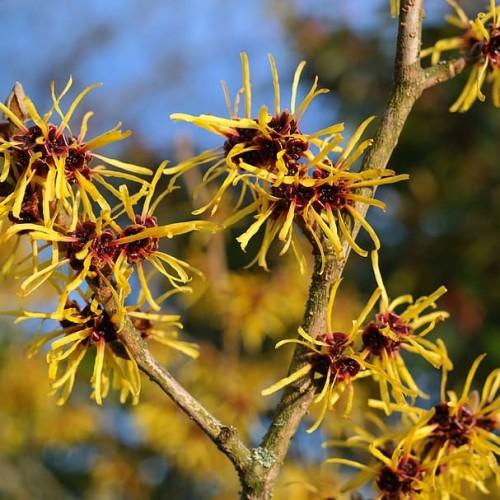
witch hazel
Hamamelis intermedia 'Westerstede'
Cycle:
Perennial
Watering:
Average
Hardiness Zone:
5 - 8
Flowers:
Flowers
Sun:
Full sun,part shade
Leaf:
Yes
Growth Rate:
Low
Maintenance:
Low
Care Level:
Medium
watering
Water witch hazel plants regularly during the growing season with about 1 inch of water per week.Water well, but then wait for the top 2 inches of soil to dry out before watering again. During periods of intense heat in the summer, provide extra water every week. Reduce the amount of water in the winter, when the plant is dormant. If the winter in your area isn’t particularly cold, continue regular watering.
sunlight
Witch hazel (Hamamelis intermedia 'Westerstede') will need 6 to 8 hours of direct sunlight daily to thrive. It will also do best in an area that receives dappled sunlight for part of the day. Plant this species in an area with a southern or western exposure, and where it will receive morning sunlight and afternoon shade. As with most other plants, too much direct sunlight can cause leaf scorch, so try to pick an area that will get a mix of sun and shade.
pruning
Witch hazel, or Hamamelis intermedia 'Westerstede', is a hardy deciduous shrub that benefits from occasional pruning. It should be pruned twice a year — once in late winter or early spring and again in the summer. Late winter or early spring pruning helps to encourage dense new growth. During this time, gently cut back any overgrown branches and thin out dense, overcrowded shrubs. For best results, start by removing dead, diseased, or damaged wood first. Next, thin out any branches that have grown in a downward direction. Finally, remove any branches crossing over each other or growing inward towards the center of the plant. Summer pruning helps to keep the plant from growing larger than you would like. During this time, remove excess vertical growth that may be shading other plants or creating an unkempt look. Selectively remove any branches that have grown too long, too wide, or too dense, but be careful to not prune off too much at once. Summing up, lightly prune witch hazel in the late winter/early spring and more heavily prune it in the summer. Pruning encourages new growth and maintains the desired size and shape so your witch hazel looks its best all season long.
